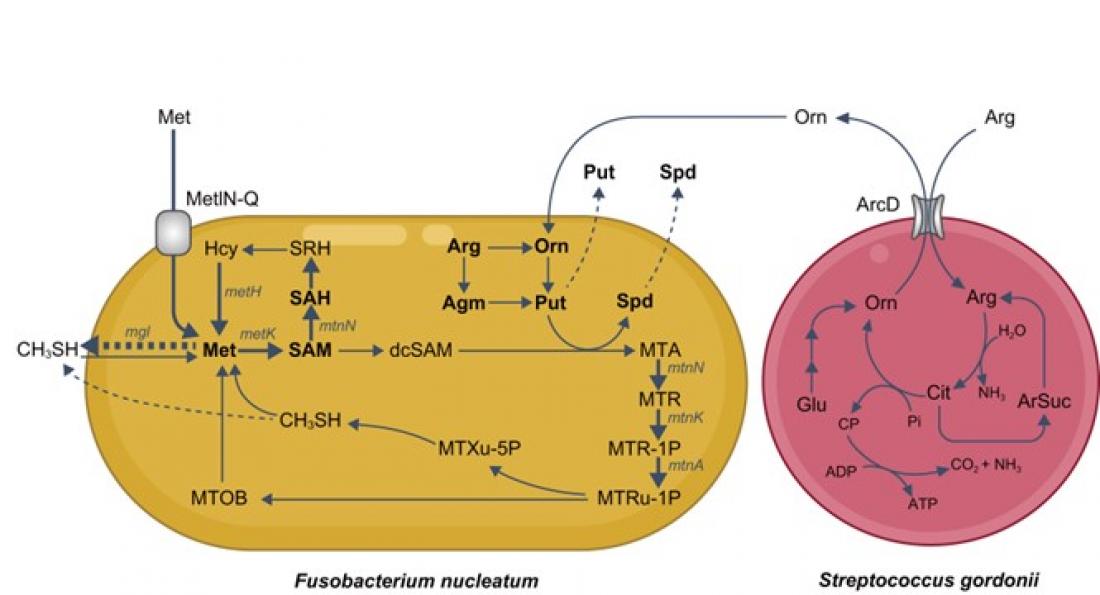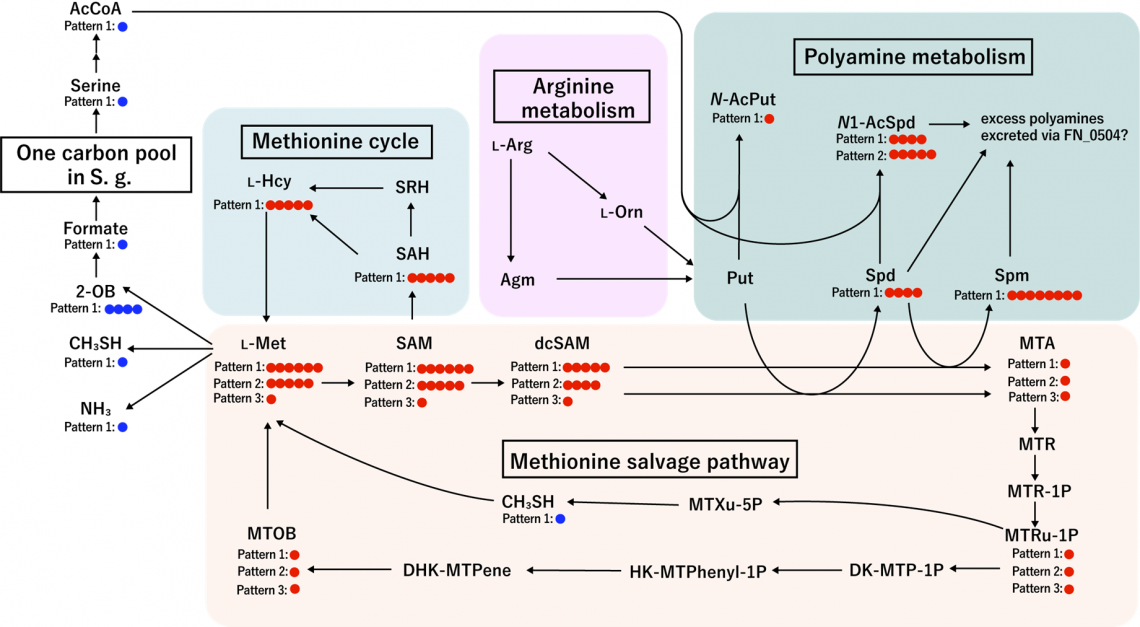Schematic representation of observed metabolic flow of bacterial metabolism F. nucleatum and S. gordonii cocultures.
Predicted flux profiling of methionine metabolic pathways in F. nucleatum.
Researchers from Osaka University find that a metabolite produced by the commensal oral bacterium Streptococcus gordonii activates another bacterial species, Fusobacterium nucleatum, to produce the malodorous compound methyl mercaptan
Osaka, Japan – Having bad breath really stinks! Now, researchers from Japan report that a particular combination of bacteria in our mouths may be responsible for producing some very unpleasant smells.
In a study published last month in mSystems, researchers from Osaka University revealed that the interaction between two common types of oral bacteria leads to the production of a chemical compound that is a major cause of smelly breath.
Bad breath is caused by volatile compounds that are produced when bacteria in the mouth digest substances like blood and food particles. One of the smelliest of these compounds is methyl mercaptan (CH3SH), which is produced by microbes that live around the teeth and on the surface of the tongue. However, little is known about which specific bacterial species are involved in this process.
“Most previous studies investigating CH3SH-producing oral bacteria have used isolated enzymes or relatively small culture volumes,” explains lead author of the study Takeshi Hara. “In this study, we aimed to create a more realistic environment in which to investigate CH3SH production by major oral bacteria.”
To do this, the researchers developed a large-volume anaerobic co-culture system that enabled them to test interactions between multiple different types of bacteria that live in the mouth. This system was able to test both direct, physical interactions among the bacteria, as well as whether these species could affect each other from a distance, for example by secreting active substances.
“The results were very intriguing,” says Masae Kuboniwa, senior author. “We found that Fusobacterium nucleatum produces large quantities of CH3SH in response to Streptococcus gordonii, another oral bacterium.”
By using stable isotope tracers and analyzing gene expression, the researchers showed that S. gordonii releases a substance called ornithine that prompts F. nucleatum to produce more of a molecule called polyamine. Because F. nucleatum needs methionine to produce polyamine, this enhanced polyamine production activates its methionine salvage pathway, which in turn results in increased CH3SH production.
“Taken together, these findings suggest that CH3SH production in the mouth is driven by the interaction between S. gordonii and F. nucleatum,” says Hara.
Understanding how these two bacterial species work together to cause bad breath could be helpful in developing ways to treat or even prevent bad breath. In addition, given that bad breath is often associated with periodontal disease, treating this symptom early could help prevent more serious damage in the future.
###
The article, “Interspecies metabolite transfer fuels methionine metabolism of Fusobacterium nucleatum to stimulate volatile methyl mercaptan production,” was published in mSystems at DOI: https://doi.org/10.1128/msystems.00764-23
About Osaka University
Osaka University was founded in 1931 as one of the seven imperial universities of Japan and is now one of Japan's leading comprehensive universities with a broad disciplinary spectrum. This strength is coupled with a singular drive for innovation that extends throughout the scientific process, from fundamental research to the creation of applied technology with positive economic impacts. Its commitment to innovation has been recognized in Japan and around the world, being named Japan's most innovative university in 2015 (Reuters 2015 Top 100) and one of the most innovative institutions in the world in 2017 (Innovative Universities and the Nature Index Innovation 2017). Now, Osaka University is leveraging its role as a Designated National University Corporation selected by the Ministry of Education, Culture, Sports, Science and Technology to contribute to innovation for human welfare, sustainable development of society, and social transformation.
Website: https://resou.osaka-u.ac.jp/en




